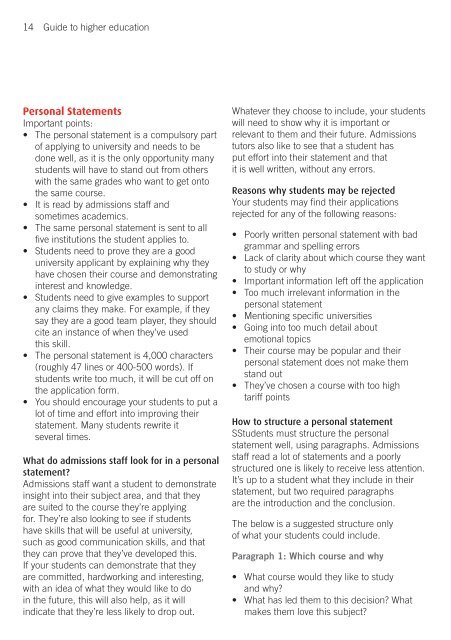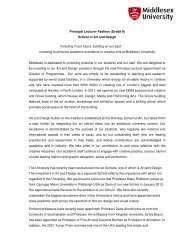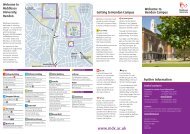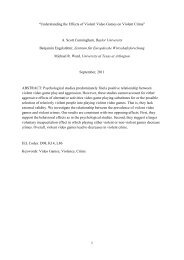Contact us: - Middlesex University
Contact us: - Middlesex University
Contact us: - Middlesex University
Create successful ePaper yourself
Turn your PDF publications into a flip-book with our unique Google optimized e-Paper software.
14 Guide to higher education<br />
Personal Statements<br />
Important points:<br />
• The personal statement is a compulsory part<br />
of applying to university and needs to be<br />
done well, as it is the only opportunity many<br />
students will have to stand out from others<br />
with the same grades who want to get onto<br />
the same course.<br />
• It is read by admissions staff and<br />
sometimes academics.<br />
• The same personal statement is sent to all<br />
five institutions the student applies to.<br />
• Students need to prove they are a good<br />
university applicant by explaining why they<br />
have chosen their course and demonstrating<br />
interest and knowledge.<br />
• Students need to give examples to support<br />
any claims they make. For example, if they<br />
say they are a good team player, they should<br />
cite an instance of when they’ve <strong>us</strong>ed<br />
this skill.<br />
• The personal statement is 4,000 characters<br />
(roughly 47 lines or 400-500 words). If<br />
students write too much, it will be cut off on<br />
the application form.<br />
• You should encourage your students to put a<br />
lot of time and effort into improving their<br />
statement. Many students rewrite it<br />
several times.<br />
What do admissions staff look for in a personal<br />
statement?<br />
Admissions staff want a student to demonstrate<br />
insight into their subject area, and that they<br />
are suited to the course they’re applying<br />
for. They’re also looking to see if students<br />
have skills that will be <strong>us</strong>eful at university,<br />
such as good communication skills, and that<br />
they can prove that they’ve developed this.<br />
If your students can demonstrate that they<br />
are committed, hardworking and interesting,<br />
with an idea of what they would like to do<br />
in the future, this will also help, as it will<br />
indicate that they’re less likely to drop out.<br />
Whatever they choose to include, your students<br />
will need to show why it is important or<br />
relevant to them and their future. Admissions<br />
tutors also like to see that a student has<br />
put effort into their statement and that<br />
it is well written, without any errors.<br />
Reasons why students may be rejected<br />
Your students may find their applications<br />
rejected for any of the following reasons:<br />
• Poorly written personal statement with bad<br />
grammar and spelling errors<br />
• Lack of clarity about which course they want<br />
to study or why<br />
• Important information left off the application<br />
• Too much irrelevant information in the<br />
personal statement<br />
• Mentioning specific universities<br />
• Going into too much detail about<br />
emotional topics<br />
• Their course may be popular and their<br />
personal statement does not make them<br />
stand out<br />
• They’ve chosen a course with too high<br />
tariff points<br />
How to structure a personal statement<br />
SStudents m<strong>us</strong>t structure the personal<br />
statement well, <strong>us</strong>ing paragraphs. Admissions<br />
staff read a lot of statements and a poorly<br />
structured one is likely to receive less attention.<br />
It’s up to a student what they include in their<br />
statement, but two required paragraphs<br />
are the introduction and the concl<strong>us</strong>ion.<br />
The below is a suggested structure only<br />
of what your students could include.<br />
Paragraph 1: Which course and why<br />
• What course would they like to study<br />
and why?<br />
• What has led them to this decision? What<br />
makes them love this subject?










